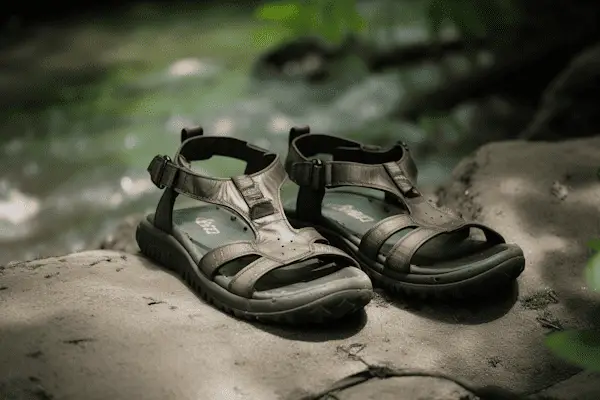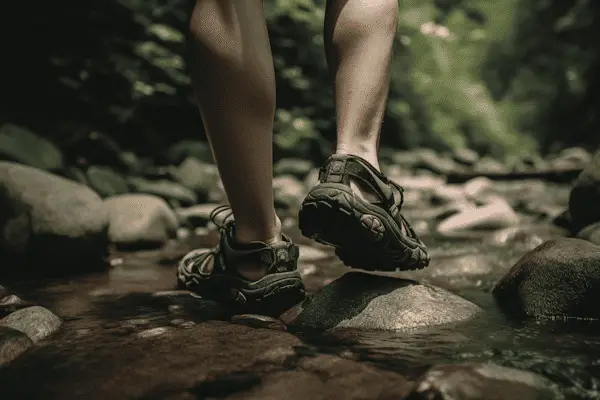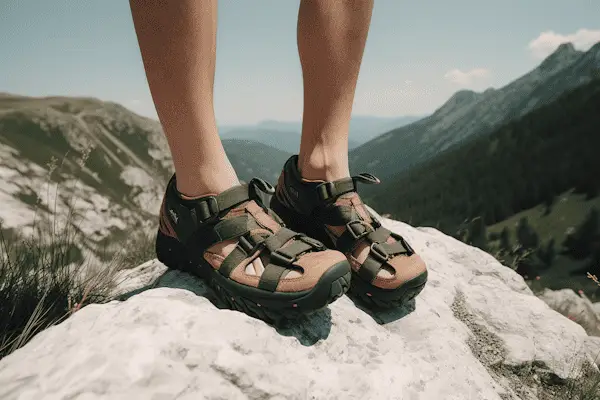Hiking sandals have become more and more popular with each year, but are hiking sandals good for hiking?
Hiking sandals can be a great option for certain types of hikes and outdoor activities. They are lightweight, breathable, and can provide good traction on rocky or uneven terrain. However, they may not be the best choice for more rugged or technical hikes, where a sturdier hiking shoe or boot would be more appropriate. Ultimately, it depends on your personal preferences and the specific conditions of your hike.

Getting to Know Your Hiking Sandals: A Look Inside
Let’s get this straight – not all sandals are created equal, especially when it comes to hiking sandals. They’re specially designed with a bunch of unique features that help you tackle those rocky trails and river crossings with confidence. So, what exactly makes them stand out from the pair of flip-flops you might wear to the beach?
Well, first off, hiking sandals have a tougher, more durable sole. It’s usually made from materials like rubber or a synthetic compound to offer solid traction on a variety of surfaces. Ever stepped on a pebble with regular sandals? Ouch! But the thick soles of hiking sandals help protect your feet from sharp objects and rocky surfaces.
Then there’s the upper part of the sandal, the bit that holds your foot in place. This is often made from hardy materials like leather or synthetic fabrics to endure the rigors of the trail, while also allowing your feet to breathe. And here’s the kicker – they typically come with adjustable straps for a customizable fit. No one wants a sandal slipping off mid-hike, right?
Finally, many hiking sandals have a contoured or cushioned footbed for extra comfort. This is super important, especially if you’re planning on a long hike. This footbed might also have some added arch support to help your foot maintain its natural alignment.
Taking a Step Forward: The Upsides of Hiking Sandals
When it comes to outdoor activities, comfort, and practicality are two of the biggest game-changers. And that’s where hiking sandals truly shine. They pack a surprising number of benefits, making them a great choice for those sunny day hikes.
Let’s start with the obvious one: breathability. The open design of hiking sandals means that your feet can breathe easily, reducing the risk of sweaty and uncomfortable feet. Imagine trekking through a beautiful forest trail on a hot day and feeling that lovely breeze around your toes. Ah, bliss!
Next up, they’re quick-drying and water-resistant. If your adventure involves crossing streams or you get caught in an unexpected downpour, no worries! Your hiking sandals can handle it. They’ll dry much quicker than traditional hiking boots, which means you can say goodbye to the squelching sound of wet boots for the rest of your journey.

And how about versatility? Hiking sandals are lightweight and less bulky than boots, making them perfect for those who like to travel light. You can easily slip them into your backpack if you need to switch footwear. Plus, they transition effortlessly from trail to town, meaning you can go from a casual hike to a café visit without needing a change of shoes.
One more thing – the break-in period for hiking sandals is typically shorter than that for boots. That means you’ll likely be able to get out there and start enjoying your hikes sooner, without the blisters and discomfort that can come with new boots.
In short, hiking sandals can be a great addition to your outdoor gear, bringing comfort, versatility, and practicality to your adventures. So why not give your feet a breath of fresh air on your next hike?
Pebbles in the Path: The Potential Downsides of Hiking Sandals
While hiking sandals can offer many benefits, they’re not without their downsides. It’s only fair we talk about these too, so you can make the most informed decision for your outdoor adventures.
First on the list: protection and support. Compared to hiking boots, sandals naturally offer less coverage. This means your toes are more exposed to potential stubs, scrapes, or bites from insects. If your trail is filled with sharp rocks, heavy brush, or prickly vegetation, a pair of boots might be a safer bet.
Then there’s the issue of ankle support. Most hiking sandals don’t provide the same level of ankle stability as boots, which could be a concern on uneven terrains or if you’re prone to ankle injuries. And let’s not forget the possibility of sand and small pebbles getting in – it might not be a deal-breaker, but stopping to shake out your sandals can get a little annoying after a while.
Also, while hiking sandals are great for warm, dry conditions, they might not be your best friend in colder weather or when it’s really wet and muddy. Without the insulation and water resistance of boots, your feet could end up feeling pretty chilly.
Last but not least, not all hiking sandals are created equal. Some might have thin soles or poor cushioning, leading to discomfort on longer treks. So it’s essential to do your homework and find a quality pair that ticks all your boxes.
In a nutshell, hiking sandals can be fantastic in the right conditions, but they do come with some limitations. Weighing up these pros and cons can help you choose the best footwear for your specific hiking needs. After all, the right pair of shoes can make or break your hiking experience.
Pros and Cons of Hiking Sandals At A Glance
| Hiking Sandal Advantages | Hiking Sandal Disadvantages |
|---|---|
| High breathability due to open design, ideal for warm weather | Limited foot and ankle protection compared to hiking boots |
| Quick drying and water-resistant | Not as suitable for rough, uneven terrains or colder climates |
| Lightweight and less bulky, easy to pack | Risk of small pebbles or debris getting into the sandals |
| Versatile for various casual activities | Some models may lack sufficient cushioning or support |
| Shorter break-in period, reducing initial discomfort | Risk of insect bites or scrapes due to open design |
Hiking Sandals Vs Hiking Boots: A Hiker’s Dilemma
The hiking boots versus hiking sandals debate is one that has rumbled on in the outdoor community for years. So let’s take a look at the major points in this friendly footwear face-off.
Hiking boots have long been the go-to choice for serious hikers. They’re designed to give you the utmost protection and support, especially in tough terrains. Got a steep mountain trail lined with rocks and roots? A sturdy pair of boots will have your back – or should I say, your feet? They’re also the preferred choice in colder climates or when you’re carrying a heavier backpack, as they provide excellent ankle support and weight distribution.
But while boots are brilliant in their way, they’re not always the most convenient. They can be heavy, bulky, and let’s be honest, they’re not exactly known for their breathability. Plus, a poorly fitted boot or a lack of break-in time can lead to uncomfortable blisters.
Enter hiking sandals. These lightweight contenders are a breath of fresh air – literally. Their open design allows for much-needed ventilation, making them perfect for warm-weather hikes. Not to mention, they’re super versatile and easier to pack for those who are conscious about saving space. Crossing a river or hiking on a rainy day? Hiking sandals dry out much quicker than boots.
However, as we mentioned before, they do fall short in offering the same level of protection and support as boots. So if your hiking plans involve rough, uneven trails or colder environments, you might want to stick with boots.
In the end, the decision between hiking boots and sandals comes down to the type of hiking you plan on doing and the conditions you’ll encounter. Some seasoned hikers even carry both on their adventures.
Tips for Choosing the Right Hiking Sandals
Here are five key areas to focus on when choosing a pair of hiking sandals:
- Fit: Ensure a snug but comfortable fit with enough room for toe movement. Remember, a poorly fitted sandal can lead to discomfort or injuries.
- Straps: Look for adjustable and easily secured straps. Bonus points if they’re padded or lined to prevent chafing.
- Sole: The sole should be sturdy and have a good grip to handle a variety of surfaces. A thicker sole offers better protection against sharp objects.
- Footbed: A contoured or cushioned footbed is a must for extra comfort. If possible, go for sandals with arch support.
- Material: Choose according to your needs. Leather may offer durability and comfort but dries slower when wet. Synthetic materials might be less durable but typically dry quickly and resist water well.
Detailed Guide to Buying Hiking Sandals
Choosing the right hiking sandals can feel a bit like a treasure hunt. You’re looking for that perfect blend of comfort, durability, and style. But don’t worry, I’ve got a few tips to guide you on your quest.
First off, let’s talk about fit. It’s super important, especially because you’ll be wearing these on uneven terrains and for extended periods. A poorly fitted sandal can cause blisters or even lead to twisted ankles. You want a snug fit – but not too tight! – with enough room for your toes to wiggle.
Next, check the straps. Are they adjustable? Can they be secured easily? Adjustable straps allow for a customizable fit, and secure fastening ensures your sandals stay put, even during more strenuous activities. Also, see if the straps are padded or lined to prevent chafing.
Take a good look at the sole of the sandal. It should be sturdy, with a good grip to prevent slipping on wet or uneven surfaces. Also, a thicker sole will provide better protection against sharp rocks and other trail hazards.

The footbed is equally important. Look for a sandal with a contoured or cushioned footbed for extra comfort, and if possible, arch support. Your feet will thank you after a long day on the trail!
Finally, consider the material. Leather might be more durable and comfortable, but it can take longer to dry when wet. Synthetic materials might not last as long but often dry quickly and resist water well.
Finding the right hiking sandals is all about knowing what to look for and understanding your own hiking needs. But remember – even the most well-designed sandal won’t make your hike enjoyable if it’s not the right fit for you. So take the time to try them on, walk around, and choose wisely!
TLC for Your Treads: Proper Care and Maintenance for Hiking Sandals
Let’s face it – hiking sandals can be a bit of an investment. But with a bit of regular care and maintenance, they can serve you well for many treks to come. So how do you keep your hiking sandals in top-notch condition? Let’s dive in!
First things first, cleaning. After a fun day on the trails, your sandals might be looking a little grubby. A simple rinse under warm running water should remove most of the dirt. For stubborn mud, use a soft-bristle brush. And remember, always avoid using harsh chemicals or detergents as they can damage the material.
Now, drying. It might be tempting to place them near a heat source or in direct sunlight to speed up the process, but resist the urge. This can lead to the materials drying out, cracking, or even shrinking. Instead, let your sandals air dry naturally in a well-ventilated area.
And how about storage? When not in use, store your sandals in a cool, dry place away from direct sunlight. Extreme temperatures and sunlight can deteriorate the materials over time.
Finally, a quick word on repair. If a strap breaks or the sole starts to come loose, don’t throw your sandals away. Many brands offer repair services or sell replacement parts. This not only extends the life of your sandals but is also a more sustainable choice.
In a nutshell, with a little care, your hiking sandals can accompany you on many outdoor adventures. And hey, they might even start to tell a story of their own – each scuff, scratch, and mark a memory of trails conquered and vistas seen. So show them some love, and they’ll love you right back!
Getting Comfortable with the Unconventional: Tips for Adapting to Hiking in Sandals
If you’re used to hiking in boots, switching to sandals might feel a bit like entering a brave new world. But with a few tips and tricks, you’ll be striding confidently along the trails in no time.
The first step? Take it slow. Just as with a new pair of boots, your feet need time to get used to hiking in sandals. Start with shorter, less challenging hikes and gradually work your way up as you feel more comfortable.

Next up, get acquainted with your straps. Hiking sandals often come with adjustable straps that let you customize the fit. Spend some time experimenting with different adjustments until you find what’s most comfortable for you. Remember, a secure fit can help prevent blisters and slipping.
Remember to protect your feet. Even with hiking sandals, it’s still important to protect your feet from the sun. Applying sunscreen, wearing breathable hiking socks, or using toe guards can all help protect your feet from sunburn and reduce the chance of injury from sharp rocks or debris.
And lastly, don’t forget about your hiking technique. You might need to alter your stride slightly when wearing sandals compared to boots, especially on rocky or slippery terrain. Practice lifting your feet higher to avoid stubbing your toes and try to place your feet more carefully to avoid sharp objects.
Making the switch to hiking in sandals can feel a bit daunting at first. But with a bit of practice, some patience, and these tips in mind, you’ll be ready to tackle those trails with your toes breathing in the fresh air.
